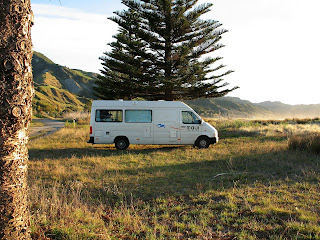I've been pointing the camera at the night sky for a long time, although it's not a regular thing, and photos are few and far between. This is partly (mainly, if I'm honest) because the clearest skies seem to occur only on the chilliest nights, and I'm averse to hanging around while making a time exposure.
So that's why, when spending two months in New Zealand in 2007, I took only one picture of the Southern Cross, the Southern Hemisphere's nearest equivalent to Ursa Major (the Plough, which circles high above in the Northern Hemisphere, and points you to the Pole Star).
Here's that shot, taken from Tokomaru Bay on the east side of North Island, on 14th April 2007:
It's the cross-shaped constellation in the upper centre of the shot. I didn't lug my tripod to New Zealand, so I must have somehow rested the camera on the campervan, facing upwards. Not too bad a result, considering.
Tokomaru Bay was a one-night stop. We got there from Wairoa, pulled up just shy of the dunes that backed the beach. and enjoyed a sunny late-afternoon admiring the pines and the scenery, while the waves creamed in.
It was a very solitary position, but we felt completely fine. Next morning, another very sunny day.
But we couldn't linger. We had a tight schedule, and had lost time earlier on in the holiday.
I got chortles in response to these purchases - I was wasting my money! I defended myself, and still do. I respected Maori culture, and wanted to take something of it home. If I ever return to New Zealand, I shall absorb the information in these books and feel more in touch with the spirit of the land, and its indigenous people.
Back to Orion!
The best previous photo I had of it was taken in March 2017, at Curlew Farm, my regular caravan destination near Lyme Regis:
That was taken with the camera that came after the little Leica, a Panasonic LX100, which had a faster lens and a larger sensor, and could produce a very good picture indeed. The lens was fast, and the usable ISO range wide, so its time exposures for stars were not long affairs. In fact this particular shot was almost too quick to be called a 'time exposure' - just one second at ISO 800 and f/1.7. Note the star at the top corner - that's Betelgeuse, a huge Red Giant star approaching the end of its lifespan. Its brightness has been fluctuating for years. Well, more recently in late 2019 it had been waxing and waning in brightness rather more than usual - a sure sign, for such a bloated star, of Something Tremendous Happening. So I wanted to take a few snaps, to see how well Betelgeuse showed up - maybe it would have become very faint.
I had got outside in mid-December, with my phone fixed to the tripod (more on that in a moment). But the other day I did the same again, with the little Leica.
I'd just rediscovered that the Leica, with its much-better controls, was a more suitable camera for shooting the night sky. I set it up carefully indoors, with a specially-devised custom setting for getting the best-exposed shot. Here it is, on the tripod in my lounge:
And this is what I got:
Hmm. There's Orion, and I can see Betelgeuse in the top-left corner of the constellation. Clearly, all present and correct. Slightly dimmer than normal? Maybe.
Now, here's the picture I took four weeks ago, with the phone. I've lightened it up, to make the stars more visible:
Where's Betelgeuse? For a brief moment, I thought, 'Betelgeuse has gone! It's become so faint that it doesn't show up in the photograph!'
That would be an interesting event indeed. And I'd captured it.
But I now think that it was there, very faint, but just out of shot. If I'd only tilted the phone up a tiny bit more, I'd have noticed it. Why didn't I manage to do that? Well, for some reason I didn't find it easy to 'aim' the phone accurately at Orion. I had to guess what would be included the upper part of the picture. I guessed wrong.
Oh well. I'll have another go ASAP at getting a picture of Betelgeuse looking oddly faded.
The Leica sits on the tripod very differently, and although its screen is smaller, it's somehow easier to work with. Well, it will be simple to repeat that first shot taken with the Leica (two photos above), and then make a direct brightness comparison.
Meanwhile, I am able to confirm that Betelgeuse is still with us.















